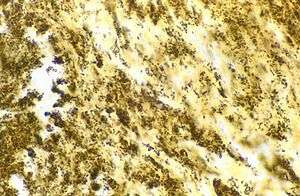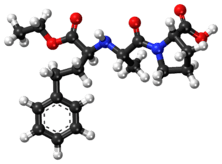Tricuspid insufficiency
| Tricuspid insufficiency | |
|---|---|
.jpg) | |
| Tricuspid regurgitation | |
| Specialty | Cardiology |
| Causes | Abnormally high blood pressure , other heart problem[1] |
| Diagnostic method | Echocardiogram[1] |
| Treatment | Diuretic, Surgery[1] |
Tricuspid insufficiency (TI), also called tricuspid regurgitation (TR), is a type of valvular heart disease where there is failure of the heart's tricuspid valve to close properly when the ventricles contracts. This defect allows the blood to flow backwards, reducing its efficiency.[1] Regurgitation may be due to a structural change of components of the tricuspid valve apparatus, a lesion can be primary (intrinsic abnormality) or secondary (right ventricular dilatation).[2]
Signs and symptoms
Signs/symptoms of tricuspid insufficiency are generally those of right-sided heart failure, such as ascites and peripheral edema.[2]
Tricuspid insufficiency may lead to the presence of a pansystolic heart murmur. Such a murmur is usually of low frequency and best heard low on the lower left sternal border. As with most right-sided phenomena, it tends to increase with inspiration, and decrease with expiration. This is known as Carvallo's sign. However, the murmur may be inaudible indicating the relatively low pressures in the right side of the heart. A third heart sound may also be present, also heard with inspiration at the lower sternal border.[3][4]
In addition to the possible ausculatory findings above, there are other signs indicating the presence of tricuspid regurgitation. There may be giant C-V waves in the jugular pulse[5] and a palpably (and sometimes visibly) pulsatile liver on abdominal exam. Since the murmur of tricupsid regurgitation may be faint or inaudible, these signs can be helpful in establishing the diagnosis.
Causes
The causes of tricuspid insufficiency can be congenital in origin.[6] Much more common than a congenital abnormality of the valve, however, is right ventricular dilatation of any cause. Such dilatation is most often the result left heart failure (of any cause) or pulmonary hypertension. Dilation leads to derangement of the normal anatomy and mechanics of the tricuspid valve and the muscles governing its proper function, with the result being incompetence of the tricuspid valve. Other common causes of right ventricular dilation include right ventricular infarction, inferior myocardial infarction, and cor pulmonale.

In regards to primary and secondary causes they are:[7]
- Primary causes
- Rheumatic
- Myxomatous
- Ebstein anomaly
- Endomyocardial fibrosis
- Endocarditis
- Traumatic (blunt chest injury)
- Secondary causes
- LV dysfunction or valve disease
- Chronic lung disease
- Pulmonary thromboembolism
- Myocardial disease
- RV ischemia
- Left to right shunt
- Carcinoid heart disease
Mechanism
In terms of the mechanism of tricuspid insufficiency it involves the expansion of the tricuspid annulus (fibrous rings of heart). Tricuspid insufficiency is linked to geometric changes of the tricuspid annulus (decreased tricuspid annular release). The leaflets shape are normal but prevented from normal working mechanism due to a distortion of spatial relationships of leaflets and chords.[8] It is also contemplated that the process via which tricuspid regurgitation emerges, is a decrease of contraction of the myocardium around the annulus,[9]
Diagnosis
In the diagnosis of tricuspid insufficiency a chest x-ray will demonstrate right heart enlargement. An echocardiogram will assess the chambers of the heart, as well as, right ventricular pressure. Cardiac magnetic resonance may also be used as a diagnostic tool, and finally, cardiac catheterization may determine the extent of the regurgitation.[3]
Management

In terms of treatment for tricuspid insufficiency prosthetic valve substitutes can be used, though artificial prostheses may cause thrombo‐embolic phenomena (bioprostheses may have a degeneration problem).[9] Some evidence suggests that there are no significant differences between a mechanical or biological tricuspid valve in a recipient.[10]
Generally, surgical treatment of tricuspid regurgitation is not indicated when it has arisen as a result of right ventricular dilatation. In such instances of secondary tricuspid regurgitation, the mainstay of therapy is medical. When left-sided heart failure is the cause, the individual is instructed to decrease intake of salt. Medications in this case may include diuretics and angiotensin-converting enzyme inhibitors.[11]
Prognosis
The prognosis of tricuspid insufficiency is less favorable for males than females. Furthermore, increased tricuspid insufficiency (regurgitation) severity is an indication of a poorer prognosis according to Nath, et al.[12] It is also important to note that since tricuspid insufficiency most often arises from left heart failure or pulmonary hypertension, the person's prognosis is usually dictated by the prognosis of the latter conditions and not by the tricuspid insufficiency per se.
See also
References
- 1 2 3 4 MedlinePlus Encyclopedia Tricuspid regurgitation
- 1 2 Tricuspid Regurgitation~clinical at eMedicine
- 1 2 "Tricuspid Valve Disease & Tricuspid regurgitation (TR) | Patient". Patient. Retrieved 2015-12-14.
- ↑ Berg, Dale; Worzala, Katherine (2006-01-01). Atlas of Adult Physical Diagnosis. Lippincott Williams & Wilkins. p. 90. ISBN 9780781741903.
- ↑ Rehman, Habib Ur (2013). "Giant C-V Waves of Tricuspid Regurgitation". New England Journal of Medicine. 369 (20): e27. doi:10.1056/NEJMicm1103312. PMID 24224640.
- ↑ Said, Sameh M; Dearani, Joseph A; Burkhart, Harold M; Connolly, Heidi M; Eidem, Ben; Stensrud, Paul E; Schaff, Hartzell V (2014). "Management of tricuspid regurgitation in congenital heart disease: Is survival better with valve repair?". The Journal of Thoracic and Cardiovascular Surgery. 147 (1): 412–419. doi:10.1016/j.jtcvs.2013.08.034. PMID 24084288.
- ↑ Rogers, J. H; Bolling, S. F (2009). "The Tricuspid Valve: Current Perspective and Evolving Management of Tricuspid Regurgitation". Circulation. 119 (20): 2718–2725. doi:10.1161/CIRCULATIONAHA.108.842773. PMID 19470900.
- ↑ Hung, Judy (2010). "The Pathogenesis of Functional Tricuspid Regurgitation". Seminars in Thoracic and Cardiovascular Surgery. 22 (1): 76–78. doi:10.1053/j.semtcvs.2010.05.004. PMID 20813321.
- 1 2 Antunes, M. J; Barlow, J. B (2005). "Management of tricuspid valve regurgitation". Heart. 93 (2): 271–276. doi:10.1136/hrt.2006.095281. PMC 1861404. PMID 17228081.
- ↑ "BestBets: Should the tricuspid valve be replaced with a mechanical or biological valve?". www.bestbets.org. Retrieved 2015-12-14.
- ↑ Tricuspid Regurgitation~treatment at eMedicine
- ↑ Nath, Jayant; Foster, Elyse; Heidenreich, Paul A (2004). "Impact of tricuspid regurgitation on long-term survival". Journal of the American College of Cardiology. 43 (3): 405–409. doi:10.1016/j.jacc.2003.09.036. PMID 15013122.
Further reading
- Haddad, F; Doyle, R; Murphy, D. J; Hunt, S. A (2008). "Right Ventricular Function in Cardiovascular Disease, Part II: Pathophysiology, Clinical Importance, and Management of Right Ventricular Failure". Circulation. 117 (13): 1717–1731. doi:10.1161/CIRCULATIONAHA.107.653584. PMID 18378625.
- Desai, Ravi R; Vargas Abello, Lina Maria; Klein, Allan L; Marwick, Thomas H; Krasuski, Richard A; Ye, Ying; Nowicki, Edward R; Rajeswaran, Jeevanantham; Blackstone, Eugene H; Pettersson, Gösta B (2013). "Tricuspid regurgitation and right ventricular function after mitral valve surgery with or without concomitant tricuspid valve procedure". The Journal of Thoracic and Cardiovascular Surgery. 146 (5): 1126–1132.e10. doi:10.1016/j.jtcvs.2012.08.061. PMC 4215162. PMID 23010580.
- Badano, Luigi P; Muraru, Denisa; Enriquez-Sarano, Maurice (2013). "Assessment of functional tricuspid regurgitation". European Heart Journal. 34 (25): 1875–1885. doi:10.1093/eurheartj/ehs474. PMID 23303656.
- al.], Hugh D. Allen ... [et; Shaddy, Robert E.; Feltes, Timothy F. (2013). Moss and Adams heart disease in infants, children, and adolescents : including the fetus and young adult (8th ed.). Philadelphia: Wolters Kluwer Health/Lippincott Williams & Wilkins. ISBN 9781451118933.
External links
| Classification | |
|---|---|
| External resources |